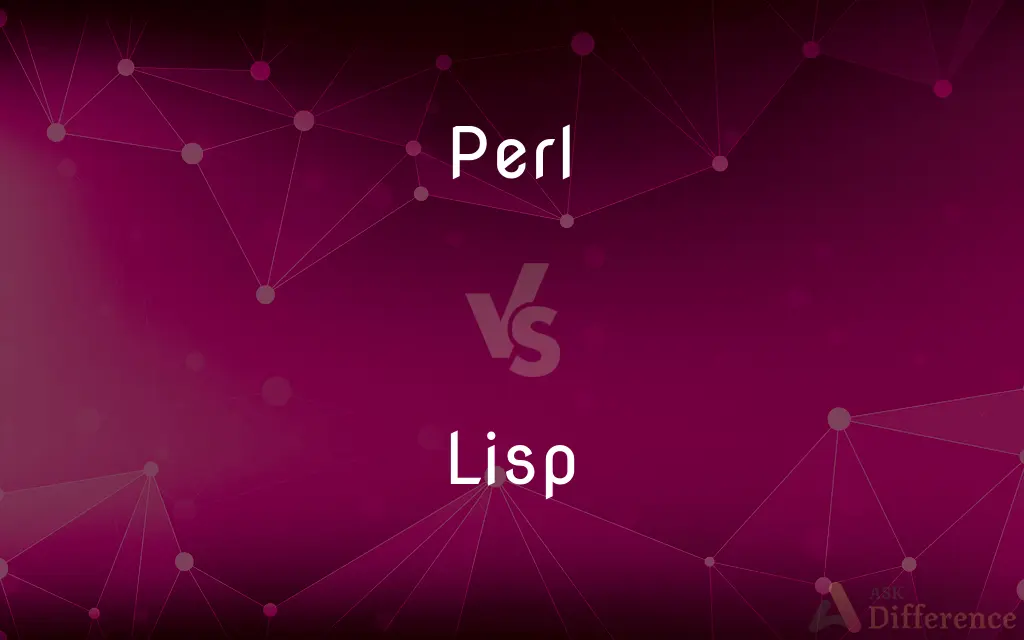Perl vs. Lisp — What's the Difference?
By Maham Liaqat & Urooj Arif — Updated on April 20, 2024
Perl, known for its text manipulation prowess, excels in scripting and web development, while Lisp is famed for its symbolic computation and AI development capabilities.

Difference Between Perl and Lisp
Table of Contents
ADVERTISEMENT
Key Differences
Perl is a high-level, general-purpose programming language created in 1987 by Larry Wall, primarily used for system administration, web development, and network programming. Whereas Lisp, introduced in 1958 by John McCarthy, is one of the oldest high-level programming languages, focusing heavily on symbolic computation and used extensively in research, particularly artificial intelligence.
Perl uses a context-sensitive syntax that can be flexible and expressive, which allows for concise and powerful text processing scripts. On the other hand, Lisp uses a fully parenthesized prefix notation which is consistent and facilitates powerful macro systems, enabling programmers to effectively manipulate code as data.
Perl has a large repository of third-party modules available via Comprehensive Perl Archive Network (CPAN), making it highly extensible. While Lisp environments are known for their unique development feature, 'Read-Eval-Print Loop' (REPL), which aids in interactive testing and debugging.
Perl's strength lies in its community's motto, "There's more than one way to do it," supporting flexibility in coding methods. Whereas Lisp is praised for its "code as data" philosophy (homoiconicity), which allows a program to easily alter its own structure, benefiting metaprogramming.
Perl is typically used in situations requiring quick scripting solutions or where text manipulation is essential, such as log file analysis. In contrast, Lisp has been a staple in academic settings, particularly for teaching computer science concepts and artificial intelligence, thanks to its high level of abstraction and support for recursive algorithms.
ADVERTISEMENT
Comparison Chart
Year Created
1987
1958
Primary Use
Web development, scripting, text processing
AI research, symbolic computation
Syntax
Context-sensitive, flexible
Fully parenthesized, consistent
Extension Libraries
CPAN (Comprehensive Perl Archive Network)
Lesser compared to Perl
Unique Features
Text manipulation, Regular expressions
REPL, Homoiconicity (code as data)
Compare with Definitions
Perl
Regular expression.
Perl uses powerful regular expressions to process text efficiently.
Lisp
Homoiconicity.
Lisp treats code as data, enabling sophisticated macro systems.
Perl
CPAN.
Perl's CPAN offers numerous ready-to-use software.
Lisp
Symbolic computation language.
Lisp processes symbols and expressions effectively.
Perl
High-level programming language.
Perl excels in creating complex scripts with less code.
Lisp
REPL (Read-Eval-Print Loop).
Lisp's REPL environment supports dynamic development and testing.
Perl
Context-sensitive syntax.
Perl's syntax adapts depending on the context, enhancing flexibility.
Lisp
AI programming.
Lisp is extensively used in developing AI applications.
Perl
Scripting language.
Perl scripts automate many system administration tasks.
Lisp
Prefix notation.
Lisp’s prefix notation ensures all operations are consistently structured.
Perl
Perl is a family of two high-level, general-purpose, interpreted, dynamic programming languages. "Perl" refers to Perl 5, but from 2000 to 2019 it also referred to its redesigned "sister language", Perl 6, before the latter's name was officially changed to Raku in October 2019.Though Perl is not officially an acronym, there are various backronyms in use, including "Practical Extraction and Reporting Language".
Lisp
A lisp is a speech impairment in which a person misarticulates sibilants ([s], [z], [ts], [dz], [ʃ], [ʒ], [tʃ], [dʒ]). These misarticulations often result in unclear speech.
Lisp
One of the first high-level programming languages, designed to handle complex data structures. It is widely used in artificial intelligence research.
Lisp
A speech defect or mannerism characterized by mispronunciation of the sounds (s) and (z) as (th) and (th).
Lisp
A sound of or like a lisp
"The carpenter['s] ... plane whistles its wild ascending lisp" (Walt Whitman).
Lisp
To speak with a lisp.
Lisp
To speak imperfectly, as a child does.
Lisp
To pronounce with a lisp.
Lisp
The habit or an act of lisping.
He used to have a terrible lisp before going to a speech therapist.
It's common for children to speak with a lisp.
Lisp
To pronounce the consonant ‘s’ imperfectly; to give ‘s’ and ‘z’ the sounds of ‘th’ (lang=en). This is a speech impediment common among children.
Until the age of 10, Dominic would lisp, but this was fixed by a speech therapist.
Lisp
To speak with imperfect articulation; to mispronounce, such as a child learning to talk.
Lisp
(archaic) To speak hesitatingly and with a low voice, as if afraid.
Lisp
(archaic) to express by the use of simple, childlike language.
Lisp
(archaic) To speak with reserve or concealment; to utter timidly or confidentially.
To lisp treason
Lisp
To pronounce the sibilant letter s imperfectly; to give s and z the sound of th; - a defect common among children.
Lisp
To speak with imperfect articulation; to mispronounce, as a child learning to talk.
As yet a child, nor yet a fool to fame,I lisped in numbers, for the numbers came.
Lisp
To speak hesitatingly with a low voice, as if afraid.
Lest when my lisping, guilty tongue should halt.
Lisp
To pronounce with a lisp.
Lisp
To utter with imperfect articulation; to express with words pronounced imperfectly or indistinctly, as a child speaks; hence, to express by the use of simple, childlike language.
To speak unto them after their own capacity, and to lisp the words unto them according as the babes and children of that age might sound them again.
Lisp
To speak with reserve or concealment; to utter timidly or confidentially; as, to lisp treason.
Lisp
A high-level computer programming language in which statements and data are in the form of lists, enclosed in parentheses; - used especially for rapid development of prototype programs in artificial intelligence applications .
Lisp
A speech defect that involves pronouncing s like voiceless th and z like voiced th
Lisp
A flexible procedure-oriented programing language that manipulates symbols in the form of lists
Lisp
Speak with a lisp
Common Curiosities
Why is Lisp preferred in AI research?
Lisp's ability to handle symbolic computation and its development flexibility make it preferred in AI research.
Can you extend Perl's capabilities?
Yes, Perl's capabilities can be extended through numerous modules available via CPAN.
How does Perl handle text processing?
Perl uses regular expressions and a variety of text manipulation techniques efficiently.
What is Perl mainly used for?
Perl is mainly used for web development, scripting, and text manipulation.
What is homoiconicity in Lisp?
Homoiconicity in Lisp means the language treats its code as data, allowing unique flexibility in programming.
How does Perl support different programming styles?
Perl supports multiple programming paradigms, including procedural and object-oriented styles.
Is Perl easy to learn for beginners?
Perl can be challenging due to its flexible syntax, but it's powerful for those who master it.
What is the key feature of Lisp's syntax?
The key feature of Lisp's syntax is its consistent use of fully parenthesized prefix notation.
What makes Lisp unique in terms of code manipulation?
Lisp's code as data philosophy allows for powerful and flexible code manipulation and macro systems.
How is Lisp used in teaching computer science?
Lisp is used to teach fundamental programming concepts and to explore computational thinking due to its abstract nature.
Share Your Discovery

Previous Comparison
Shrub vs. Scrub
Next Comparison
Milliard vs. MillionAuthor Spotlight
Written by
Maham LiaqatCo-written by
Urooj ArifUrooj is a skilled content writer at Ask Difference, known for her exceptional ability to simplify complex topics into engaging and informative content. With a passion for research and a flair for clear, concise writing, she consistently delivers articles that resonate with our diverse audience.














































